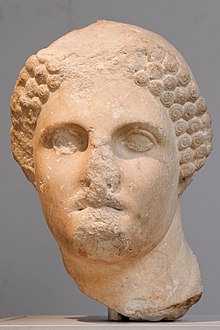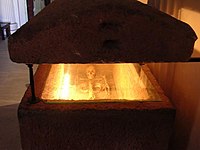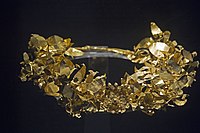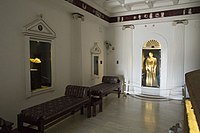Ada of Caria
| Ada | |
|---|---|
 Portrait of a young woman from the Mausoleum at Halicarnassus, sometimes identified as Ada. British Museum. | |
| Satrap of Caria (first reign) | |
| Reign | 344–340 BC |
| Predecessor | Idrieus |
| Successor | Pixodarus |
| Queen of Caria (second reign) | |
| Reign | 334-326 BC |
| Predecessor | Orontobates |
| Successor | Alexander III (the Great) of Macedon |
| Born | 4th century BC Mobolla, Persian Empire (modern-day Muğla, Turkey) |
| Died | 326 BC Halicarnassus, Caria (modern-day Bodrum, Muğla, Turkey) |
| Consort | Idrieus |
| House | Hecatomnids |
| Father | Hecatomnus |
| Hecatomnid dynasty (Dynasts of Caria) | ||||||||||||||||||
|---|---|---|---|---|---|---|---|---|---|---|---|---|---|---|---|---|---|---|
|
||||||||||||||||||
Ada of Caria (Ancient Greek: Ἄδα) (fl. 377 – 326 BC)[1] was a member of the House of Hecatomnus (the Hecatomnids) and ruler of Caria during the mid-4th century BC, first as Persian Satrap and later as Queen under the auspices of Alexander III (the Great) of Macedon.[2]
History[edit]
Ada was the daughter of Hecatomnus, satrap of Caria, sister of Mausolus, Pixodarus, Artemisia, and Idrieus.[3]
While Adas father is known to have been Hekatomnos,the identity of her mother is less clear. There is a possibility that her mother might have been Aba,[4] daughter of Hyssaldomos and a sister of Hekatomnos. This view however is challenged by scholars who believe either that the sibling marriages of the Hecatomnids were purely symbolic in nature and that while Ada was attested as his consort, it is not known if she was the mother of Hekatomnos children.[5]
Four of the siblings intermarried: Mausolus wed Artemisia, while Ada was married to her brother Idrieus.[3] Pixodarus married outside of the family.[3] Every child of Hecatomnus would govern over Caria at some point.[3] Mausolus and Artemisia first ruled together,[3] and after Mausolus' death, Artemisia ruled alone until she died in 344 BC.
Idrieus and Ada ruled together for four years, until his death.[3] During their rule, they kept close ties to the Hellenic world.[6] The joint regents were mentioned as donors to the Temple of Athena in Tegea, and seem to have also been major patrons of Delphi.[6] After the death of her husband, Ada became the sole satrap of Caria, but was expelled by her brother Pixodarus in 340 BC. Upon his death in 335 BC, was succeeded by his own son-in-law, the Persian Orontobates. Ada fled to the fortress of Alinda, where she maintained her rule in exile.[7]
When Alexander the Great entered Caria in 334 BC, Ada adopted Alexander as her son and surrendered Alinda to him.[8] Alexander accepted her offer and, in return, gave Ada formal command of the Siege of Halicarnassus.[9] After the fall of Halicarnassus, Alexander returned Alinda to Ada and made her queen of all of Caria.[10] Ada's popularity with the populace in turn ensured the Carians' loyalty to Alexander.[2]
"Ada meanwhile held only Alinda, the strongest fortress in Caria; and when Alexander entered Caria she went to meet him, surrendering Alinda and adopting Alexander as her son. Alexander gave Alinda to her charge, and did not reject the title of son, and when he had taken Halicarnassus and became master of the rest of Caria, he gave her command of the whole country."
She was under the protection of Asander, Hellenistic satrap of Lydia.
-
Agora of Alinda, Ada's Stronghold.
-
The siege and capture of Halicarnassus under Alexander the Great
Ada sarcophagus[edit]
According to Turkish archaeologists, the tomb of Ada has been discovered, although this claim remains unresolved. Her remains are on display in the archaeological museum of Bodrum.[11]
-
Purported skeleton of Ada, Bodrum Museum of Underwater Archaeology
-
Reconstruction of Ada, Bodrum Museum. She was 1.62m tall, and about 40 years old when she died.
-
Wreath of Ada, Bodrum Museum of Underwater Archaeology
-
Room dedicated to the Carian Princess in the Bodrum Museum.
-
Jewelry worn by the princess in the sarcophagus.
-
Jewelry worn by the princess in the sarcophagus.
-
Reconstruction of the head of the deceased, aged about 40.
Notes[edit]
- ^ 377 BC is the date of her father's death: Gardner, Percy (1918). A History of Ancient Coinage, 700-300 B.C. Clarendon Press: Oxford University. p. 303.
- ^ a b c Fabre-Serris, Jacqueline; Keith, Alison (2015). Women and War in Antiquity. JHU Press. p. 236. ISBN 9781421417622.
- ^ a b c d e f Sears, Matthew A. (2014). p.213
- ^ Cadwallader, Alan H.; Trainor, Michael (2011-12-07). Colossae in Space and Time: Linking to an Ancient City. Vandenhoeck & Ruprecht. ISBN 978-3-647-53397-1.
- ^ Carney, Elizabeth D.; Müller, Sabine (2020-11-09). The Routledge Companion to Women and Monarchy in the Ancient Mediterranean World. Routledge. ISBN 978-0-429-78398-2.
- ^ a b Sears, Matthew A. (2014). p.217
- ^ McNicoll, Milner; McNicoll, Anthony; Milner, N. P. (1997). Hellenistic Fortifications from the Aegean to the Euphrates. Clarendon Press. p. 26. ISBN 9780198132288.
- ^ Sears, Matthew A. (2014). "Alexander and Ada Reconsidered". Classical Philology. 109 (3): 211–221. doi:10.1086/676285. ISSN 0009-837X. JSTOR 10.1086/676285. S2CID 170273543.
- ^ "Geography". Perseus.org. Retrieved 1 May 2015.
- ^ Arrian. "Chapter XXIII". The Anabasis of Alexander.
- ^ "Carian Princess Hall". Bodrum Museum of Underwater Archaeology. Retrieved 1 May 2015.
References[edit]
- E.D. Carney, "Women and Dunasteia in Caria", American Journal of Philology 126 (2005), pp. 65–91.
- W. Heckel, Who’s Who in the Age of Alexander the Great, Oxford (Blackwell), 2006, p. 3
- Attilio Mastrocinque, La Caria e la Ionia meridionale in epoca ellenistica, 323-188 a. C. (Rome, 1979)
- Stephen Ruzicka, Politics of a Persian dynasty : the Hecatomnids in the fourth century B.C. (1992)
- Simon Hornblower, Mausolus (1982)
- Bean, George E. (1971). Turkey beyond the Maeander. London: Praeger. ISBN 0-87471-038-3.
- Livius, Ada Archived 2013-05-01 at the Wayback Machine by Jona Lendering
- Ada from Smith, Dictionary of Greek and Roman Biography and Mythology (1867)
- Photos of Halicarnassus Includes a picture of the skeleton of Ada.
- Henry Gardiner Adams, ed. (1857). "Ada". A Cyclopaedia of Female Biography: 5. Wikidata Q115290624.










